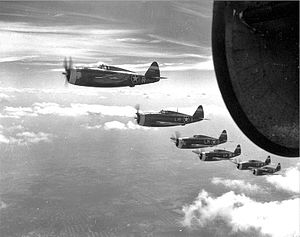Operation Pointblank
| Operation Pointblank | |||||||
|---|---|---|---|---|---|---|---|
| Part of Strategic bombing campaign in Europe | |||||||
 USAAF P-47 Thunderbolt fighters, assigned to protect 8th Air Force bomber formations and to hunt for German fighters. |
|||||||
|
|||||||
| Belligerents | |||||||
|
|
|
||||||
| Commanders and leaders | |||||||
|
|
|||||||
The Pointblank directive authorised the initiation of Operation Pointblank, the code name for the primary portion of the Allied Combined Bomber Offensive intended to cripple or destroy the German aircraft fighter strength, thus drawing it away from frontline operations and ensuring it would not be an obstacle to the invasion of Northwest Europe. The Pointblank directive of 14 June 1943 ordered RAF Bomber Command and the U.S. Eighth Air Force to bomb specific targets such as aircraft factories, and the order was confirmed when the Allies met at the Quebec Conference, 1943.
Up to that point the RAF and USAAF had mostly been attacking German industry in their own way – the British by broad night attacks on industrial areas and the US in "precision attacks" by day on specific targets. The operational execution of the Directive was left to the commanders of the forces and as such even after the directive the British continued in night attacks and the majority of the attacks on German fighter production and combat with the fighters was down to the USAAF.
In practice the USAAF bombers made large scale daylight attacks on factories involved in the production of fighter aircraft. The Luftwaffe was forced into defending against these raids, and its fighters were drawn into battle with the bombers and their escorts. It was these battles of attrition that reduced the Luftwaffe strength despite increases in German aircraft production.
At the January 1943 Casablanca Conference, the Combined Chiefs of Staff agreed to conduct the Combined Bomber Offensive (CBO), and the British Air Ministry issued the Casablanca directive on 4 February with the object of:
...
Wikipedia
